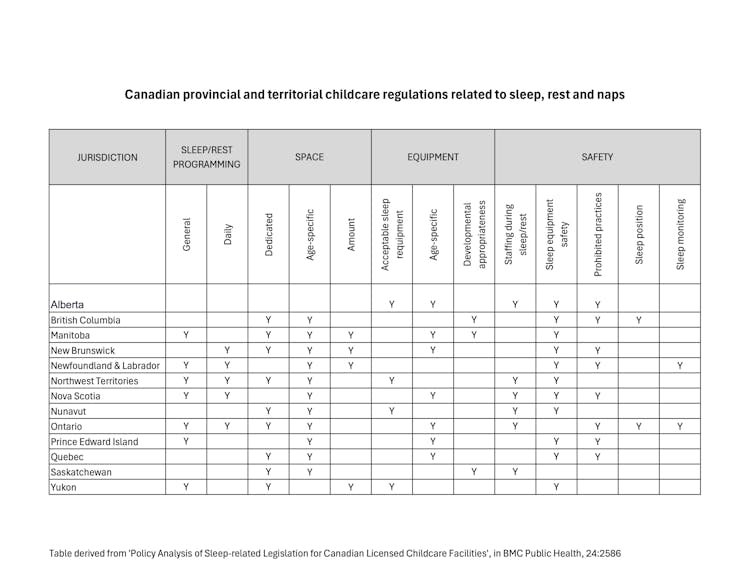Rewrite the
In 2023, more than half of Canadian children (up to five years old) were in child care and more than 25 per cent of young children were on a wait list. Many children are in child care for several hours per day and multiple days per week. Parents control children’s nighttime sleep but rely on early learning and child-care providers to help children safely meet sleep needs during the day.
But what direction are Canadian licensed childcare facilities receiving from government statutes and regulations about young children’s sleep? Evidence indicates no guidance from statutes, and inconsistent and lacking sleep regulations for licensed child care in Canada, resulting in neglect of children’s sleep needs.
Adequate sleep improves children’s attention, behaviour, learning, memory, emotional regulation, quality of life, and mental and physical health. Canadian 24-hour movement guidelines for healthy development include children’s needs for physical activity, sedentary time and sleep. They recommend naps for infants and children under two years, and nap options for ages three to four.
(Shutterstock)
Two authors of this story have doctoral degrees in nursing. One author has a doctoral degree in psychology. Our fourth author is a team member for the Canadian Child Care Federation. We are all engaged in promoting children’s and parents’ health and well-being. As a nurse researcher, Wendy Hall has worked with parents and community and professional institutions to promote children’s healthy sleep.
Problems with government regulations
There are many examples of problems with government regulations for sleep in licensed child-care facilities. Only two jurisdictions have regulations specifying that child-care providers monitor children’s well-being during sleep. Only two jurisdictions have regulations stipulating that infants be positioned to sleep on their backs. The Canadian Paediatric Society has clear guidelines about positioning infants on their backs.
Despite clear 24-hour movement guidelines for children’s sleep, only two jurisdictions have regulations that specify amount of sleep/rest per day in licensed child care. Most jurisdictions specify infant-based sleep spaces, but definitions of infants vary (from 12 to 23 months). Only five jurisdictions ban supplying drinks and food while children are napping/resting. Some jurisdictions prohibit playpens, cradles and/or bassinettes for sleeping while others include them as acceptable sleep equipment.

(Wendy Hall), Author provided (no reuse)
Child-care providers need more guidance
Lack of specificity in regulations creates gaps in guidance for child-care providers who decide how much sleep children need.
Sleep duration needs are constantly changing between the ages of four months and 18 years. Providing appropriate regulations for sleep/rest periods that fit children’s developmental stages can avoid inappropriate mandates by child-care facilities for children’s sleep. For example, many centres provide only one rest period per day. One period may not meet infants’ needs, or may exceed the needs of three- to four-year-olds.
Lack of consistent regulations for naps in licensed child-care facilities across Canada may increase inequity. Research has shown that children who live in socio-economically disadvantaged neighbourhoods have shorter nighttime sleep and take longer to fall asleep at night. Naps may be important for children from lower socio-economic backgrounds to compensate for poor nighttime sleep.
Some jurisdictions produce manuals to help interpret statutes and regulations, but many manuals are years out of date.
Research into action

(Shutterstock)
Our research has identified problems with Canadian regulations about children’s sleep in licensed child-care facilities. This knowledge requires action.
Government legislatures would benefit from lobbying about necessary statutory and regulatory guidance for children’s healthy sleep by groups like the Canadian Sleep Society and Canadian Paediatric Society.
Parents could benefit from using the Canadian Paediatric Society website information to advocate for their children’s healthy sleep in child care.
Child-care providers’ professional development about promoting healthy sleep would benefit children and parents, but sleep education for health-care providers and allied disciplines is lacking.
We don’t know about parents’ comfort with advocating for their children’s healthy sleep. Are they concerned about negative reactions from child-care providers if they raise concerns? Do parents feel well-informed about their children’s sleep needs? Two authors of this story are members of a team that has applied for funding to study pre-school children’s changes in naps, accounting for sleep in child care.
Preschool children’s optimal sleep is more likely when parents, researchers and child-care providers collaborate to create guidelines and lobby for legislative change.
This article was also co-authored by Robin McMillan, who is the Innovator of Projects, Programs and Partnerships with the Canadian Child Care Federation.
in HTML format to be seo optimized related to this title
Lack of sleep regulations in Canada’s licensed child-care facilities puts children’s health at risk
. Create appropriate headings and subheadings to organize the content. Ensure the rewritten content is approximately 1000 words. Ensure to strip all images from final output i dont need images.At the end of the content, include a “Conclusion” section and a well-formatted “FAQs” section.Ensure there are no additional notes and introductory text in the final output.Final output is gonna publish directly as post content so keep in mind provide only rewritten post content without any introductory text or notes in result and kindly dont explain what you done or what you provided as output of this prompt
Recommended Products:
-

EcoNugenics – ecoSleep – 60 Capsules – Professionally Formulated to Support Healthy Circadian Rhythm & Deep, Sleep – Safe, Natural & Effective
$45.00 Buy Now -
Sale!

Sleep Gummies for Adults & Kids | Melatonin Gummies with Chamomile, Valerian & L Theanine | Safe & Effective for Kids & Adults | Vegan Childrens Melatonin 3mg, 1.5 mg, or 6mg (2-Pack, 120 Gummy)
Original price was: $34.99.$27.95Current price is: $27.95. Buy Now -

Garden of Life Organics Elderberry Immune Support for Kids with Zinc, Vitamin C – Kids Elderberry & Sleep Immune Syrup Liquid, Bedtime Herbs for Children, No Alcohol, No Added Sugar, 3.92 fl oz
$16.78 Buy Now



